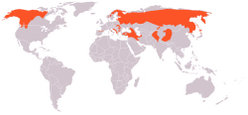Brown Bear
The Brown Bear (Ursus arctos) is a species of bear that can reach weights of 130–700 kg (300–1500 pounds). more...
The Grizzly Bear (Ursus arctos horribilis), the Kodiak Bear and the Mexican Brown Bear are North American subspecies of the Brown Bear. It is sometimes referred to poetically as the bruin.
Appearance
Brown Bears have furry coats in shades of blonde, brown, black, or a combination of those colors; the long outer guard hairs are often tipped with white or silver, giving a "grizzled" appearance. Brown bears have a large hump of muscle over their shoulders which give strength to the forelimbs for digging. Their forearms end in massive paws tipped with extremely powerful claws that can be up to 15 cm in length. Unlike the claws of other large predatory animals, such as lions or tigers, the claws are not retractable. This gives the claws a dull edge when compared to other predators. The Brown Bear possesses tremendous power; a large specimen can break a bison's spine with one blow of its powerful forepaw. Despite the relatively dull edges to their claws, the sheer force of a blow from a large specimen is devastating. Their heads are large and round with a concave facial profile. In spite of their size, some have been clocked at speeds in excess of 56 km/h (35 mph). Along with their strength and deceptive speed, Brown Bears are legendary for their physical stamina. They are capable of running at full speed for miles at a time without stopping. The largest subspecies of the Brown Bear are the Kodiak Bear and Alaskan Coastal Bear. It is not uncommon for a large male Kodiak to stand 10 feet in height while on its hind legs, and weigh over 680 kg (1,500 lb). The tallest bears have been known to reach heights of 4 m (13 feet) when standing. The largest bear ever recorded was a Kodiak that weighed over 1134 kg (2500 lb) that was brought to the Berlin Zoo directly from Kodiak Island. Bears of this size weigh near 1500 kg (3307 lb) in the zoo, due to regular feeding.
Habitat
Once native to Asia, the Atlas Mountains in Africa, Europe and North America , brown bears are now extinct in some areas and have had their numbers greatlly reduced in others. They prefer semi-open country, usually in mountainous areas. The Brown Bear ranges from Alaska east through the Yukon and Northwest Territories, south through British Columbia and through the western half of Alberta. Isolated populations exist in northwestern Washington, northern Idaho, western Montana, and northwestern Wyoming.
- The subspecies U. arctos horribilis (the Grizzly Bear) is the common brown bear of continental North America;
- The subspecies U. arctos middendorffi (Kodiak Bear) includes bears on the Alaskan islands of Kodiak Island, Afognak Island, and Shuyak Island.
- The range of the subspecies U. arctos nelsoni is in northern Mexico.
- In Asia, the Himalayan Brown Bear (U. arctos isabellinus) is found in the foothills of the Himalaya,
- and the Higuma or Hokkaido Brown Bear (U. arctos yesoensis) is found on the northern Japanese island of Hokkaido.
It is not known how long Ursus arctos has existed in North America. While there were certainly some there during the last part of the Ice Age, it is thought that the Brown Bear was not the dominant carnivore at the time. That role belonged to the far larger, taller, and stronger Giant Short Faced Bear, aka Bulldog Bear, which was almost certainly dominant when the two animals met. The Giant Short Faced Bear was adapted for fast running and meat from rather large animals was the main part of its diet, in contrast to the Grizzly or Brown Bear, which has teeth adapted to an omnivorous diet. The Giant Short Faced Bear, on average, weighed twice as much as the Grizzly, despite some exceptional Grizzly Bears in the later Old West that were recorded to have grown to 800 kilograms or so.
Read more at Wikipedia.org



